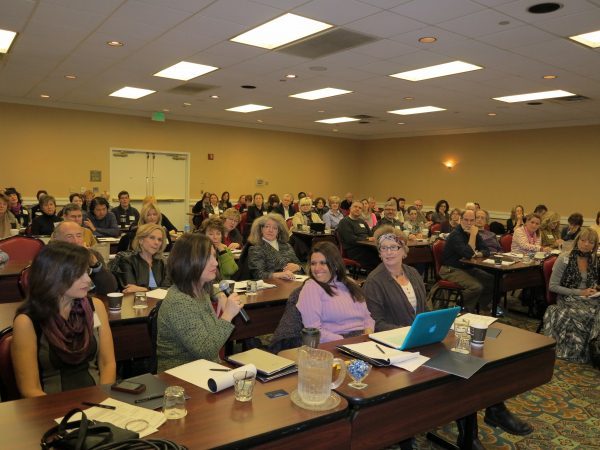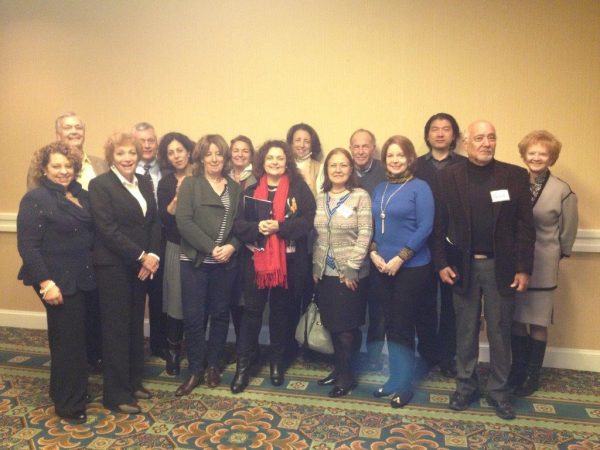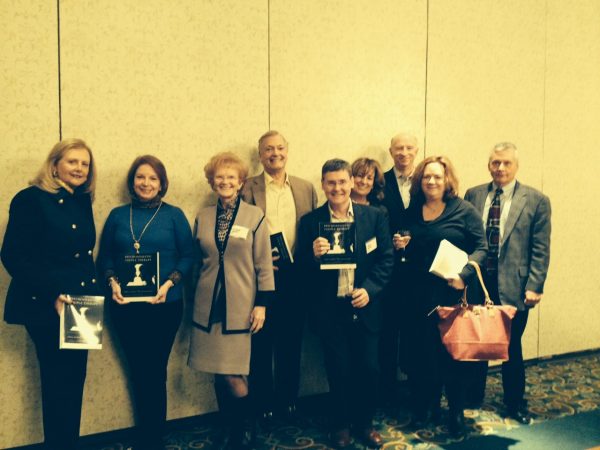At the IPI weekend ‘Inside the Mind of the Child and the Parent” October 17-19, 2014, Vali Maduro and Janine Wanlass made an interesting distinction among our therapeutic approaches with adults, adolescents, and children. We adjust our approach to their manner of communicating unconscious conflict: Adults communicate in words and dreams; children communicate in play, and adolescents communicate in actions. Jill Scharff described the importance of working with couples as parents. We open a space for them to talk about their child, hear their complaints and disappointments, help them face their fears, and develop with them an emotional language with which they can think about and communicate with their child. Some of them may work in depth, seeing how they express the link to their own parents and to each other in the way that they parent their children, and learning how their difficulties as a couple tend to reflect unconscious aspects of their couple conflict.
Category: Uncategorized
Judith Chused, MD on the use of the analyst
To see us as separate beings with minds of our own, patients must have the capacity for mentalization. But they lose it temporarily in the course of therapy. Thus at times we are seen as real objects and at other times we become transference objects, misperceived in the light of forbidden fantasies, desires and affects, our neutrality hidden under a transference veil. It is the therapist’s abstinence that encourages thickening, of the transference veil. We want it to thicken so that we can see it clearly. Working with this transference over the course of treatment draws back the veil and allows the patient to see the analyst as a new object for use in the continuing development of the person.
News of IPI participants at the TCCR-IPI summer institute in London
David Scharff and Janine Wanlass led a collaboration with TCCR to join in teaching and group-leading at the TCCR 2014 summer school “When a Twosome Becomes a Threesome: Developing and Advancing Skills in Couple Therapy” held at the Tavistock Centre for Couple Relationships in London, England. David and Janine were joined by Jill Scharff and Caroline Sehon of IPI’s Child, Couple and Family program faculty. Participants in the summer school included IPI members Frank Barone, Sam Filomena, Karen Greenberg, Jenina Lepard, Carla Trusty-Smith, and Joseph Weber, and IPI couple therapy videoconference participants Matitiaou Schliachter (from Israel) and Tertia Myers (from South Africa).
In the advancing skills track, Janine and Caroline related their presentations to the summer school theme “When a Twosome Becomes a Threesome” whereas David showed a video on projective identification. Others presenting from TCCR included teachers who have participated at IPI – Andrew Balfour, Pierre Cachia, Chris Clulow, David Hewison, Damian McCann, and Mary Morgan. Twice a day there were small discussion groups that we co-led with our TCCR partners. Janine was partnered with Liz Hamlin, Jill with Patsy Rhys, David with Viveka Nyberg, and Caroline with David Hewison as co-leaders of these groups. These were clinical case discussion groups to which the co-leaders consulted, not affective learning groups, as we have at IPI.
The group led by Janine and Liz, which was in the developing track, entered into discussion of clinical cases, where participants began to consider how couple work differs from individual work, the complicated transferences that emerge in couple work, and points of impasse in conducting couple treatment. Janine found that working with Liz and blending leadership styles from IPI and TCCR created a productive atmosphere for students to explore couple dynamics.
The groups led by David, Jill and Caroline in the advancing skills group were faced with a late change in the task. Our groups were to apply a modified version of the “Tuckett model” to process notes presented by each of the participants on an ongoing couple therapy (Tuckett et al. 2008). The original Tuckett model focuses on one case intensely over 2 days. Under the leadership of David Hewison, Head of Research at TCCR, the Tuckett model was modified to focus intently on 5 aspects of 6 cases over the 4 days of the summer school, and of course it applied to couple therapy process notes, not psychoanalysis. The group carried out the task by listening to a therapist’s process notes from a couple therapy, and without further input initially from the therapist, and categorizing what had happened in answer to 5 key questions (adapted from Tuckett) about the case material that they presented. These questions comprised (a) What does the couple therapist listen to, as evidenced by the therapist’s response? (b) How does the clinician envisage the clinical situation? (c) What is the couple therapist’s model of change? (d) What does the clinician think will further the clinical process? (e) What is in the way of the couple realizing a healthier relationship? At times, some participants resisted this challenging task, feeling frustrated that they didn’t get the “supervision” that they came for, and missing the freedom to say whatever came to mind. At other moments, students recognized the value of learning from a vantage point that differed from the experience-near, affective learning model. Many students left feeling quite intrigued by the model, and reported that it sharpened their thinking about diverse elements of theory and technique and how these are influenced by the interplay of culture, therapist training, and other factors.
Enthusiastic participants wrote about their experiences: “My associations to various lectures and discussions continue both in sessions and in other parts of my life. One concept that crystalized for me was the notion that couples have a ‘Third Position’ which involves the relational container and how this position can be greatly affected by others brought into it. I’m fascinated by the therapist’s action to enter and affect that space, and work with projective elements in it with the goal of enhancing its holding function for the couple” (Frank Barone, USA).
“The most rewarding part of the TCCR Summer School was to finally meet the faces from the videoconferencing in the flesh. Feeling quite isolated in South Africa at times, it was wonderful to have a sense of being part of an international community of couple therapists. The small group/case presentations were the most challenging part of the Summer School and it proved hard to stick to thinking about what the therapist was thinking and intending. All in all it was a very enriching experience” (Tertia Myers, SA).
“One highlight from the TCCR experience for me included the multicultural perspectives evident in how therapists work with their cultural context and dynamics. South Africa, Australia, Israel, Italy, England, US were all represented in our small group!I enjoyed exposure to the Tuckett model as a different way to think together about various therapy approaches within a psychoanalytic spectrum, and I appreciated the space at the conclusion of the week to consider other applications of the model based upon what did and didn’t work as well this time around. It was fun to make new friends from around the globe, to see the TCCR in operation and meet in person those with whom I have studied on video conference for many years!” Carla Trusty-Smith.
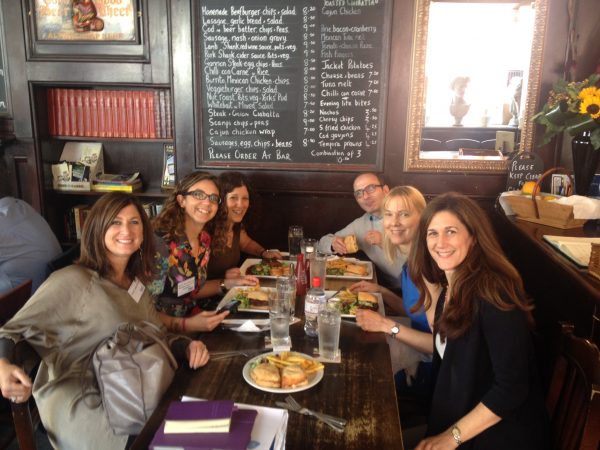
“I thoroughly enjoyed sharing the struggles and satisfaction of applying psychodynamic principles to couples work. A big surprise for me was how the concept of projective identification became vividly animated when I experienced it applied to couples work. I began to learn to help partners untangle and reclaim their best and/or most painful parts of themselves in order to provide fertile ground for genuine intimacy to grow in their relationship” (Joseph Weber).
On a social yet serious note, the whole conference decamped to the theatre to enjoy Skylight, the David Hare play about the rekindling of a relationship between an older widowed man and his former live-in lover, played by Bill Nyghe and Carey Mulligan. During the intermission, because the performance was being filmed, we were privileged to hear a live interview with the playwright by Emma Freud (Freud’s great-granddaughter) the host of National Theatre Live. In the conference the next day, a spirited discussion evolved concerning the echoes of oedipal triumph and guilt, dependency and independence, and the clash of values between the wealthy and those (like therapists) committed to service.
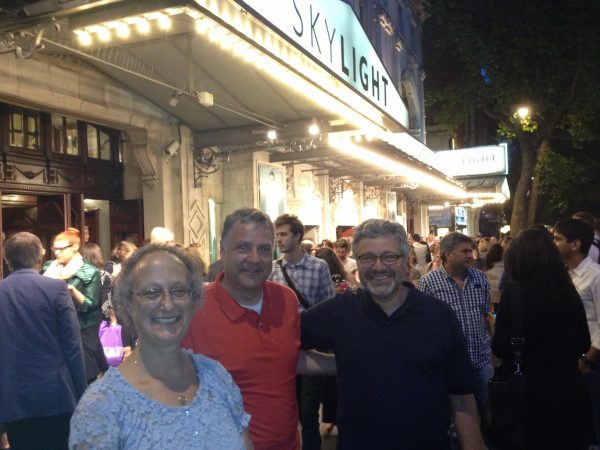
At the close of the conference, TCCR held a book-launch reception for the newly released Karnac book Psychoanalytic Couple Therapy: Foundations of Theory and Practice, edited by David and Jill Scharff with the collaboration of David Hewison, Christel Buss-Twachtmann and Janine Wanlass. The book, a co-operative compendium on how to work with couples in psychoanalytic psychotherapy, features chapters by those at IPI and TCCR who have given presentations and discussions in the videoconference course on couple therapy organized by David and Janine. Professor Brett Kahr introduced Psychoanalytic Couple Therapy as “the most comprehensive” book on the topic, “the most rigorous, and the most readable, and written, moreover, with the profundity of understanding offered by the psychoanalytical lens.” He predicted that it would “become the standard textbook in our field.” Over a glass of wine and a few tasty appetizers, we savored the culmination of our efforts, and expressed our gratitude for the fruitful collaboration of TCCR and IPI.
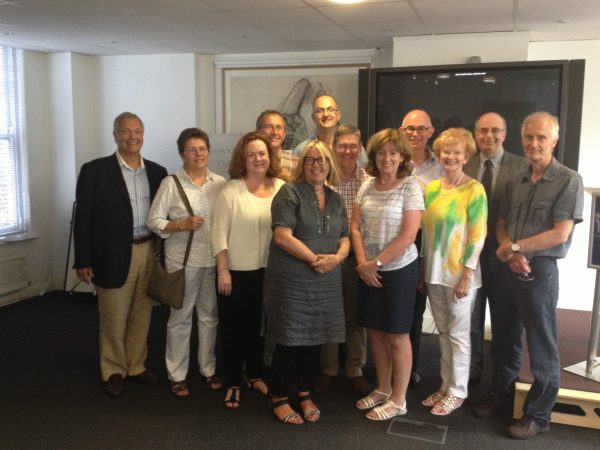
We all enjoyed our co-leading pairs, and made time to talk together after our groups. We learned again about the privilege of a good environment for the learning task and the importance of processing our experiences with our groups. During the summer institute, several conference participants, some of whom had not previously encountered IPI, expressed an interest in joining the IPI-TCCR couple therapy video-seminar series. David and Janine hope to create an equally compelling summer institute on couple and family therapy in Greece on the island of Rhodes next summer in partnership with Anastasia Tsamparli of the University of the Aegean.
Tuckett, D. et al. (2008). Psychoanalysis Comparable and Incomparable. London: Routledge.
News of IPI participants at the IACFP Congress in Bordeaux, France
Caroline Sehon, Chair of IPI-Metro and Mary Morgan, Head of MA and Clinical Training in Couple Psychoanalysis and Psychotherapy at the Tavistock Centre for Couple Relationships (TCCR) were elected, and Lea Setton and Hanni Mann-Shalvi were both re-elected, to the Board of the International Association of Couple and Family Psychoanalysis (IACFP) at the end of its Sixth Congress in Bordeaux, France. Their election is important as the IACFP governing body reorganizes to improve access to the English-speaking minority and foster greater networking amongst organizations, such as the European Federation for Psychoanalytic Psychotherapy, the International Psychoanalytic Association, and the British Society of Couple Psychotherapists and Counsellors.
At the opening ceremony in the elegant Hotel de Ville, analytic couple therapists from around the world were welcomed by the office of the mayor and the outgoing president of IACFP, Alberto Eiguer, who introduced the theme “Body, Family, Couple” translated in three languages. David Scharff was the invited speaker in English (with serial translations read by Jill Scharff and Lea Setton, with thanks to Vali Maduro for translation help). He spoke on issues encountered in teaching couple psychoanalysis in China, a traumatized country where traditional psychiatric treatment has focused on symptoms expressed in the body of the individual.
Each morning a plenary presentation with simultaneous translation featured keynote speakers including Andrew Balfour and Hanni Mann-Shalvi, both of whom are known to IPI as presenters in the videoconference course on couple therapy. David co-chaired one of these plenaries.
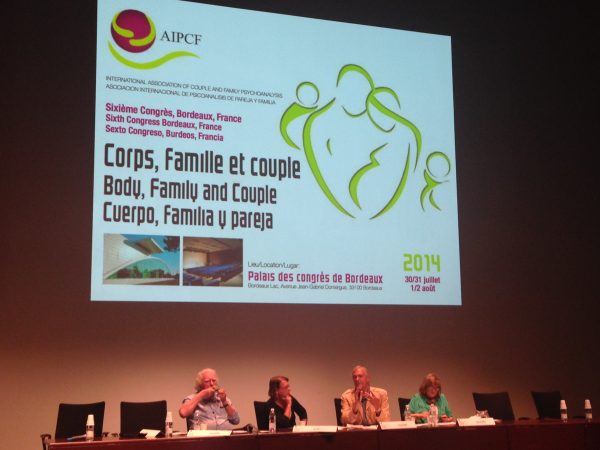
We noticed that the French and Spanish-speaking presenters relied heavily on Kaës, Pichon-Rivière, and Anzieu, with much less reference to Bion and Winnicott than is common at IPI.
Each afternoon there were small, single-language panels. At one of these, David and Jill Scharff presented a clinical case to illustrate the cultural issues introduced in his address at the opening ceremony. Jill chaired an English-speaking panel that included Maureen Boerma, Training Director of TCCR, and Anastasia Tsamparli (with whom David and Janine Wanlass are collaborating to organize a summer institute in Rhodes next summer). Maureen applied Bion to couple therapy, using many vignettes from various couples: Anastasia applied Ogden’s theory of the third in a couple whose histories kept them locked in a destructive dyad that posed a challenge. Chris Vincent chaired a panel on the family body, and he presented a paper of a couple case in which the partners’ history of early trauma led to a shared defensive system against separation anxieties which were understood within the transference-countertransference. Caroline Sehon and Lea Setton presented a case illustrating how a family’s unmentalized trauma was expressed through psychosomatic links as illustration of Pichon-Rivière’s theory.
At the closing reception, we had fun winetasting, dining and dancing to a jazz trio in the cellar of Chateau du Taillan, a working vineyard.
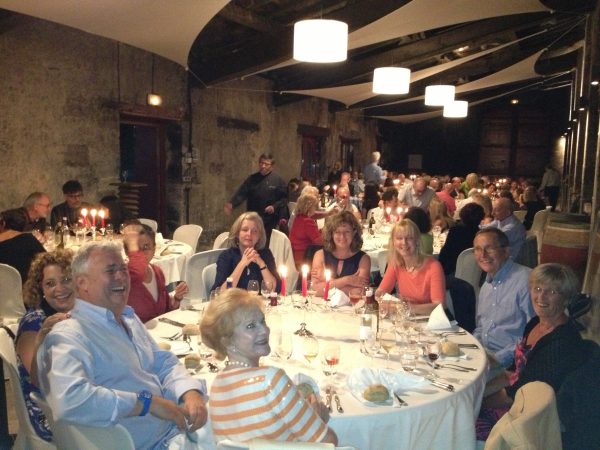
Ferro on the IPI’s Group Affective Model
Ferro said that in the few days of this weekend conference he had not tried to convey concepts. He is grateful for all the models he has learned over the years (Bion, Klein, Winnicott, Ogden), but what matters to him most is the democracy of models; for instance, Ogden’s “the analytic third” can be thought of as being a concentration of “the field” and an equivalent to the concept of “the link” introduced by Pichon-Riviere and elaborated by the Barangers. At this moment Alpha function and Beta elements are not so important to him. He said that what matters is to have an experience together, to share our ideas, and to think about how the mind works. His aim in this workshop was to show us how to create an atmosphere that allows the patient to come alive and be creative and then to co-construct an experience that is transformative. Ferro said that he appreciated the warm, free atmosphere at the International Psychotherapy Institute in which we could dream together and create a narration. He likes the group affective model developed at the International Psychotherapy Institute and hopes to export it to his own teaching.
“I appreciate the warm, free atmosphere at the International Psychotherapy Institute in which we can dream together and create a narration. I like very much the group affective model developed at the International Psychotherapy Institute and I want to export it!” Antonino Ferro, President, Italian Psychoanalytic Association.
Memoir of the future and the defense against knowledge
Having studied the analytic process as one in which the Beta elements are represented in images (pictograms) and then in narrative form, we moved on to look at the process that occurs in reverse, in Frederico Fellini’s dream book. Fellini had a daily habit of writing down his dreams and then drawing the image that came to mind. Ferro showed us that the drawing serves as the interpretation of the dream—no further narration, and no analyst in sight—and that completed the process until the night when the next dream could occur. Looking at a sequence of Fellini’s dream-text-picture records, we saw a progression from terror and loss to manic defense and resolution with acceptance of depressive anxiety. Like Fellini, we face the risk of plunging into depression, but we can use the fuel form the energy of the paranoid-schizoid position to arrive at a state of integration that is full of life. As we discussed this material in the large group, many minds were brought to bear on the dreams and the relevance to self-analysis and analytic therapy with patients. In Ferro’s way of putting it, based on Bion, the group brings many Alpha functions to bear on puzzling material, a super-Alpha function that he calls Gamma function, and this allows for a much richer appreciation of the material presented to us, richer for us, and for him.
An observation of Antonino Ferro’s discussion
Ferro showed us how to think of the history as a collection of facts or as a dream dreamt by the presenter of the case history. When a patient describes an avoidant attachment to a withdrawn and unresponsive mother, we can think of her as a dead mother. The patient may react by feeling dead or exploding in rage because all the messy, needy feelings of the baby cannot be taken in and metabolized, but return like a boomerang that misses its target and settles in the mind of the baby. The mother is dead to the infant’s need for having its Beta elements taken care of, but since she is alive in general she cannot be mourned. This problem has to come alive in the field for any transformation to occur. In the clinical situation, the person with this history has to find a way in to the field, but has no entry strategy. So the person may shut down and give up trying or may explode into the therapist’s mind, unless the therapist is able to open the door and allow entry. This opening of the door is more effective than making interpretations that penetrate the vulnerable, withdrawn or raging infant mind and are felt as persecutory rather than understanding.
IPI welcomes Antonino Ferro
Distinguished analyst Antonino Ferro, president of the Italia Psychoanalytic Association, opened our April Weekend Conference by presenting his unique approach to the clinical situation as a waking dream. The therapist receives unmetabolized proto-emotions generated in the here-and-now of the therapeutic relationship and contains them, first as a pictogram (image), until he/she can present them as a narrative. How does the therapist develop and enlarge the capacity to contain? This is the topic we will explore for the rest of this intensive weekend conference with our special guest, Antonino Ferro.
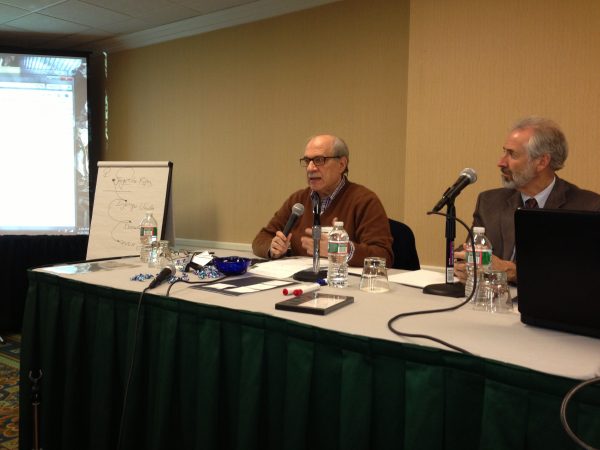
IPI February Weekend Conference
Couple and Family Psychoanalysis Around the World
Monica Vorchheimer (BA), Mary Morgan (UK), Elizabeth Palacios (Madrid), Félix Velasco Alva (Mexico); John Zinner (Washington); Karen Proner (New York), Lin Tao (London and Beijing); and Susana Muszkat (San Paulo) who participate in an IPA working group chaired by David Scharff came to join IPI faculty and guests as presenters or discussants in couple and family psychoanalysis at the February core program weekend and its preconference day co-sponsored by IPI and the IPA working group.
Photo 1. Weekend conference on couple and family psychoanalysis
The weekend conference co-chaired by David Scharff and Janine Wanlass looked at difference and similarity in theory and practice around the world, and particularly at beginnings – beginnings of sessions, of treatments, new beginnings within treatments that became moments of change.
Photo 2: IPI and IPA presenters
Back Row: David Scharff. Rich Zeitner (USA), Susana Muszkat (Brazil), Karen Proner (USA), Monica Vorchheimer (Argentina), John Zinner (USA), Lin Tao (UK and China), Jill Scharff (USA)
Front Row: Hanni Mann-Shalvi (Israel), Teresa Popiloff (Argentina), Mary Morgan (UK), Elizabeth Palacios (Spain), Delia de Cierda (Mexico), Yolanda Varela (Panama), Félix Velasco Alva (Mexico)
100 participants gathered to teach and learn about the differences among European, North and South American approaches to theory and practice of couple and family therapy. We heard clinical examples that showed transference and countertransference noted at the beginning of contact and evolving over the months of treatment; difficulty in dealing with a hidden agenda in two beginning sessions; opening the space for discussion of trauma and shame in a consultation; how the initial conditions affected the outcome of a couple therapy; and ambivalence in making a first appointment as a displacement from ambivalence over reconnecting with a wife after renouncing an affair that gave the partners the illusion that they were stabilizing a marriage.
Photo 3. Felix Velasco and Delia de Cierda (presenters) Lea Setton (session chair), Caroline Sehon (discussant)
We explored the value of theory and looked for similarities and differences among couple and family analysts around the globe. We compared and contrasted projective identification (from British object relations) and link theory (from Pichon- Rivière in South America) as concepts applied to couple and family work. We presented those theories as quite different, and yet it was hard to establish clear lines of difference because of individual variation in how our concepts are defined, both concepts being polyvalent. We presented differences in technique in terms of how much data various analysts want to have before delving into process and how comfortable others are with waiting and not knowing versus intervening to be helpful, whether in a presentation or in a therapy session. Some analysts prefer to ask about history in a routine manner, while others ask only at moments of affective exchange. There was a trend towards seeing the South American approach as one more comfortable in the present moment, while the American one was seen as more data driven, more directive.
These differences were presented as culturally determined, and yet we noted individual variations within each culture. In any case, I felt that our differences were far outweighed by our similarities in valuing containment of anxiety, invitation to inquiry, following the affect, interpretation, and above all, developing a therapeutic relationship and tuning in to the unconscious as the route to therapeutic action. We presented cases in a variety of ways – case summary and overview of analytic process, process notes, and video – in order to provide various points of access for various learning styles. Taken together the diverse methods of presentation and the varying ways of offering entry into therapeutic process, offered a more whole object for contemplation. We’re looking forward to more collaboration between IPI and the IPA at the Congress in Boston 2015, and possibly before then in Buenos Aires.
Book Launch at IPI
Overseas guests Mary Morgan and Lin Tao were joined by local IPI faculty who had authored chapters in the new book Psychoanalytic Couple Therapy, edited by David and Jill Scharff, with the collaboration of David Hewison, Christel Buss-Twachtmann and Janine Wanlass, for the USA launch of this book, a joint effort by the International Psychotherapy Institute (IPI) and Tavistock Centre for Couple Relationships.(TCCR). The book is based on the jointly offered course given over the last four years by video link, which has had participants from the United States and overseas in the UK, Central America, Israel, South Africa, Turkey and Hong Kong.
Photo 4. Chapter authors celebrating at the launch of Psychoanalytic Couple Therapy (left to right) Lea Setton, Yolanda Varela (Panama), Jill Scharff, David Scharff (USA) Damian McCann, Mary Morgan (UK), Mike Stadter, Janine Wanlass and Richard Zeitner (USA)
Photo 5. Psychoanalytic Couple Therapy book
Comments about Psychoanalytic Couple Therapy:
- “Shows the mental functioning of couples and families as fantasmatic organisms, the intertwining of intrapsychic and interpersonal levels, and the new frontiers opened by this approach.” Anna Maria Nicolo, President, Italian Society for Psychoanalysis of Couple and Family
- “Numerous, lively, in-depth clinical examples which bring the couples and the clinical dilemmas to life” Joanna Rosenthall, Tavistock and British Psychoanalytic
- “An updated, sophisticated approach to the diagnosis and effective treatment of the broad spectrum of couples’ difficulties.” Otto Kernberg, Past President, International Psychoanalytical Association
Book Review: Shrink Rap, by Dinah Miller, Annette Hanson, and Steven Roy Daviss
Scharff, J. S. (2013). Book review of Shrink Rap. In Psychodynamic Psychiatry 41(3): 473-477. Posted by permission of Guilford Press.
Shrink Rap, by Dinah Miller, Annette Hanson, and Steven Roy Daviss, Johns Hopkins University Press, Baltimore, MD, 2011, 255 pp.
As a psychoanalyst, I was not drawn to the title of this book, Shrink Rap, or to its focus on psychiatry with barely a mention of psychoanalysis. As a psychiatrist, I was not drawn to it either, given I had already been immersed in psychiatry and had left it behind. Once into the book, I found plenty of useful information, and I quite enjoyed its survey of the field. This book, however, is not intended for professionals. It is for consumers of psychiatric services. A trade book! Surely an unconventional choice for an academic press, I thought, until I realized that Johns Hopkins Press includes similar titles in its catalogue. As an academic publication, Shrink Rap falls short in that, although there is an index, a list of further reading, and any research or literature drawn from is mentioned in the text, there is no bibliography as one might expect in a book from an academic press. Nevertheless, as a trade book, Shrink Rap is well written, well crafted, accurate, and forthright. In being clear, comprehensive, informative, and impartial, it is scholarly in its own way. True to their mission, the authors write as thoughtful friendly guides to the psychiatric system, respectfully explaining the competencies of various mental health professionals in relation to the book’s main focus—the practice of psychiatry from outpatient to inpatient setting, clinic to private practice, voluntary to involuntary treatment, severe mental illness to personality disorder. It interested me to read the book from the point of view of patients who face this array when they present with a problem, as well as from my own perspective as an analyst. Where would psychoanalysis fit in the scheme of things?
Written for patients and their families, Shrink Rap is a wealth of information, clearly presented. After years of experience writing a blog and creating podcasts, three Maryland physicians—Dinah Miller, a general outpatient psychiatrist, Annette Hanson, forensic psychiatrist, and Steven Roy Daviss, consultation-liaison psychiatrist and specialist in clinical informatics—know the needs and concerns of patients and their families and how to address them clearly and simply. Now they have distilled their collective wisdom and experience in this book. Readers can ask questions and post comments about the book and engage with the authors and other patients and families on the authors’ blog. The authors, who express their academic authority in a friendly professional voice, have constructed a really well written, easily accessible, reliable consumer guide with access to follow-up discussion. In short, Shrink Rap is a well-supported trade book, offered, however, by an academic press.
Accompanying the authors on this walk through the system are fictional patients. I always have a problem with this device because it cannot accommodate the movement of the unique individual unconscious. The “patients” are composites put to the service of representing types of illness such as attention deficit disorder, delinquency, depression, addiction to drugs and pornography, panic and eating disorders, bipolar depression, and schizophrenia, and illustrating various approaches by psychiatrists who vary from remote to effusive, respectful to exploitative. Patients and psychiatrists working in treatment demonstrate the strengths and weaknesses of the system, the therapeutic relationship, pharmaceuticals, and newer invasive therapies. At one end of the spectrum of satisfactory care, there’s Tara, her panic disorder treated successfully with drugs and weekly supportive and exploratory psychotherapy, and at the other end there’s Becca who bounces from one psychiatrist to another, feeling misunderstood, rejected, embraced, and eventually betrayed. There’s the fictive Brandt family whose members are given to suffer individually—Stuart from grief reaction, Jack with hallucinosis found to be caused by a brain tumor, rapid cycling bipolar disorder (that’s Becca), Richard addicted to pornography, and Frank who is simply in a developmental transition. Later we meet Mitchell who is receiving hospital care for relapsing schizophrenia, and orphaned, hyperactive Eddie who is followed from the juvenile justice system to his incarceration as an adult drug user and sex offender in a setting where at last he could develop into a responsible adult.
Shrink Rap is such an omnibus of information and possible scenarios that it is surprising to note a few omissions. The next edition might include telepsychiatry in which psychiatrists deliver quality mental health care direct to patients who live remote from specialist centers and provide consultation or supervision to their local physicians and therapists via videoconference. Perhaps the authors do not endorse this innovation, but it is a growing part of the field of psychiatry and therefore a significant omission. Conjoint therapies are also overlooked. Why, I wonder, did no psychiatrists recommend couple therapy for Richard and his wife, or family therapy for the whole Brandt family? Readers are not given enough information about the parents, the previous generation, and the current sociocultural setting to guess at the Brandt family unconscious that connects to individual psychopathology. There is little but a passing mention of psychoanalysis, the foundation for understanding human conflict that underlies symptoms. The authors do refer to the childhood history of each patient and its effect on perception and feeling toward the treating psychiatrist but they do not apply this knowledge fully in their clinical narratives. I regret that patients and their families cannot use this book to learn how their situation has arisen or how to work through to a better adjustment. To be fair, the authors do not claim to write a guide to self-help treatment, only a guide to the system. Their fictional patients and treatment situations do serve to illustrate what can happen to people who must traverse the ins and outs of psychiatric services. But the authors could have done more to encourage reflection on the patient’s self.
I appreciate that the authors are scrupulously and refreshingly honest. Their chapter featuring Becca and her troubled course of treatment with a series of psychiatrists—of whom none were quite right and one of whom broke professional boundaries to feed her own narcotic habit—is so chilling that they might have excluded it to save face, but they wisely left it in as a cautionary tale. They present and illustrate the ethics of psychiatry even-handedly, acknowledge ethical dilemmas candidly, and discuss questionable decisions in a nonjudgmental way, always recognizing the grey areas. They acknowledge areas of debate and controversy in psychiatry. Their examples show that any of the psychotherapies for mental illness take second place to the prescription and management of psycho-pharmaceutical agents, and they ac- knowledge that drug management earns the doctor much more money in 15-minute increments than can be made in a 50-minute therapy hour. The authors admit to not knowing. They confront ignorance and uncertainty in many aspects of this new and inexact science. They mention inadequacies among practitioners, limitations of research, discrimination in insurance reimbursement policy, and difficulties arising in diagnosis and treatment. They discuss the risks and benefits of a national health information data storage system. In short, they give an accurate, comprehensive, unvarnished overview of the medico-legal-psychiatric system.
Reading as a mature psychiatrist I came away with a refresher on areas of the field from which my subspecialty has taken me away. Reading as a psychiatry trainee, one would find Shrink Rap useful in that it provides a detailed, comprehensive view of the field, a description of many of the psychoactive drugs in use, and a nonjudgmental account of the three major forms of psychotherapy. Trainees who identify with the authors’ approach will come away with a broad perspective on issues in the field and a humane, respectful, ethical stance. They will be encouraged to develop curiosity about the emotional life of their patients and their histories, but they will not develop any analytic sensibility or deep understanding of the human condition.
Reading as a psychoanalyst, I was sad, but not surprised to note the tiny place psychoanalysis has in the mind-set of the general psychiatrist. Shrink Rap reflects current perceptions that drive psychiatric residency training and mental health insurance policy. Psychoanalytically informed treatment has been slow to subject itself to research because the psychodynamic therapeutic relationship is too complex to reduce to simple criteria ready for measurement, but attachment research and neuroscience are now showing how the therapist’s capacity for empathy, containment, and attunement provide conditions conducive to affect regulation and brain growth. Intensive psychotherapy, however, calls for a big investment of time and money by patient and therapist in training. Consequently, psychodynamic or insight-oriented psychotherapy, once the staple of psychiatry, is now less often prescribed than quicker, evidence-based, results-focused methods with circumscribed goals that can be subjected to quantitative research. As a psychoanalyst, having been an analysand myself, I know from professional and personal experience that an open-ended psychodynamic, interpretive approach that takes account of the dynamic unconscious and its effect on the therapeutic relationship offers insight out of which personal growth develops. But I do not find this value embodied in this book. Psychoanalysis receives a mention as an option for those who seek to know themselves better to fulfill their potential, especially as psychotherapists, but it is not fully described, illustrated, or applied to the discussion of vignettes.
Psychoanalysis is most visible by its absence in Shrink Rap. Reading this book is a hard lesson for the psychoanalyst and psychodynamic psychotherapist. It serves up a sharp dose of reality and a painful reminder of how society has come to view mental illness and the means to wellness.
Jill Savege Scharff, M.D.
6612 Kennedy Drive
Chevy Chase, MD 20815-6504

